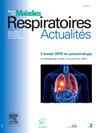Classification des néoplasmes neuroendocrines pulmonaires et impacts sur la pratique clinique
Q4 Medicine
引用次数: 0
Abstract
Pulmonary neuroendocrine neoplasms (NENs) have been classified since the 2021 WHO classification as neuroendocrine tumors (NETs), including typical low-grade G1 carcinoids (CT) and atypical intermediate-grade G2 carcinoids (CA), and high-grade malignant neuroendocrine carcinomas (NEC), including large cell neuroendocrine carcinomas (LCNEC) and small cell carcinomas (SCLC). The diagnostic criteria adopted in 2021 for all NETs remain similar to those used in the 1999 WHO classification. However, recent histomolecular data enabled to better characterize a new entity, Grade 3 NET, with NET morphology but a mitotic count and Ki67 proliferation index of LCNEC, and NETs with a poor prognosis with genomics similar to LCNEC or “supra-carcinoids.” There are also two histomolecular groups of LCNEC whose therapeutic management differs according to their genomic profile, as well as different variants of SCLC identified based on their transcriptomic expression profile, with diagnostic and probably therapeutic implications in the future.
肺神经内分泌肿瘤的分类及其对临床实践的影响
肺神经内分泌肿瘤(NENs)自2021年WHO分类以来被划分为神经内分泌肿瘤(NETs),包括典型的低级别G1类癌(CT)和非典型的中级别G2类癌(CA),以及高级别恶性神经内分泌癌(NEC),包括大细胞神经内分泌癌(LCNEC)和小细胞癌(SCLC)。2021年对所有蚊帐采用的诊断标准仍与1999年世卫组织分类中使用的诊断标准相似。然而,最近的组织分子数据能够更好地表征一种新的实体,3级NET,具有NET形态,但LCNEC的有丝分裂计数和Ki67增殖指数,以及预后较差的NETs,基因组学类似于LCNEC或“超类癌”。还有两种LCNEC的组织分子组,其治疗管理根据其基因组谱而不同,以及基于其转录组表达谱确定的SCLC的不同变体,在未来具有诊断和可能的治疗意义。
本文章由计算机程序翻译,如有差异,请以英文原文为准。
求助全文
约1分钟内获得全文
求助全文
来源期刊

Revue des Maladies Respiratoires Actualites
Medicine-Pulmonary and Respiratory Medicine
CiteScore
0.10
自引率
0.00%
发文量
671
 求助内容:
求助内容: 应助结果提醒方式:
应助结果提醒方式:


